AUDI S6 2008 Owners Manual
Manufacturer: AUDI, Model Year: 2008, Model line: S6, Model: AUDI S6 2008Pages: 390, PDF Size: 88.42 MB
Page 211 of 390
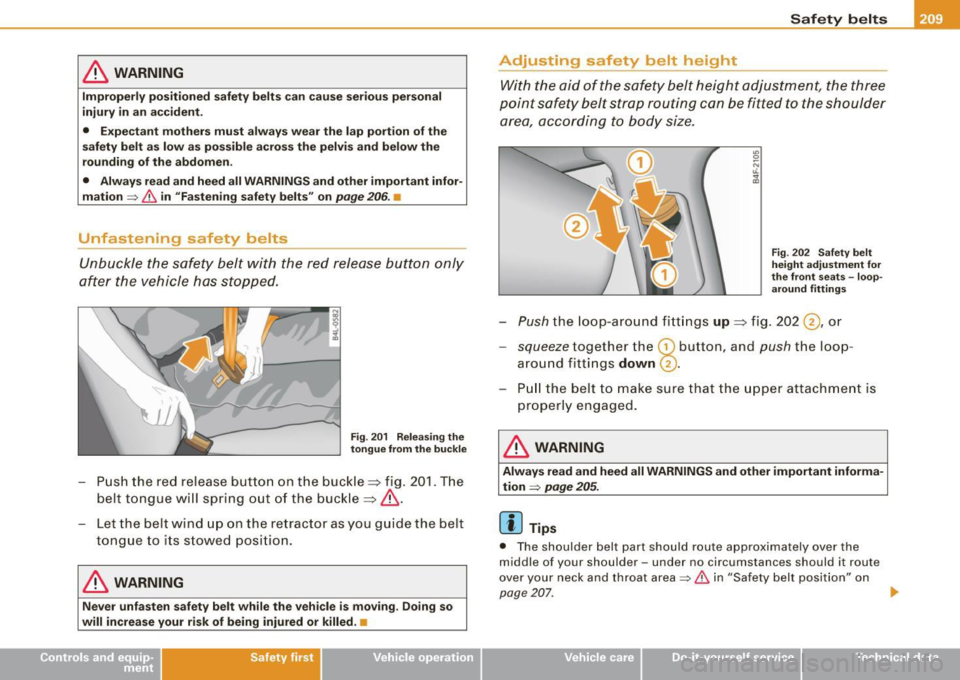
& WARNING
Improperly positioned safety belts can cause serious personal
injury in an accident.
• Expectant mothers must always wear the lap portion of the
safety belt as low as possible across the pelvis and below the
rounding of the abdomen.
• Always read and heed all WARNINGS and other important infor
mation
=> & in "Fastening safety belts" on page 206. •
Unfastening safety belts
Unbuckle the safety belt with the red release button only
after the vehicle has stopped.
~ .. a,
Fig . 201 Releasing the
tongue from the buckle
- Push the red release button on the buckle~ fig. 201. The
belt tongue will spring out of the buckle
~ & .
- Let the belt wind up on the retractor as you guide the belt
tongue to its stowed position.
& WARNING
Never unfasten safety belt while the vehicle is moving. Doing so
will increase your risk of being injured or killed. •
Safety first
Safety belts
Adjusting safety belt height
With the aid of the safety belt height adjustment, the three
point safety belt strap routing can be fitted to the shoulder
area, according to body size.
Fig . 202 Safety belt
height adjustment for
the front seats -loop
around fittings
Push the loop -around fittings up ~ fig. 202 @, or
- squeeze together the G) button, and push the loop
around fittings
down @.
- Pull the belt to make sure that the upper attachment is
properly engaged.
& WARNING
Always read and heed all WARNINGS and other important informa
tion
=> page 205.
[ i ] Tips
• The shoulder belt part should route approximately over the
middle of your shoulder -under no circumstances should it route
over your neck and throat area=>
& in "Safety belt position" on
page~Z •
•
Vehicle care I I Technical data
Page 212 of 390
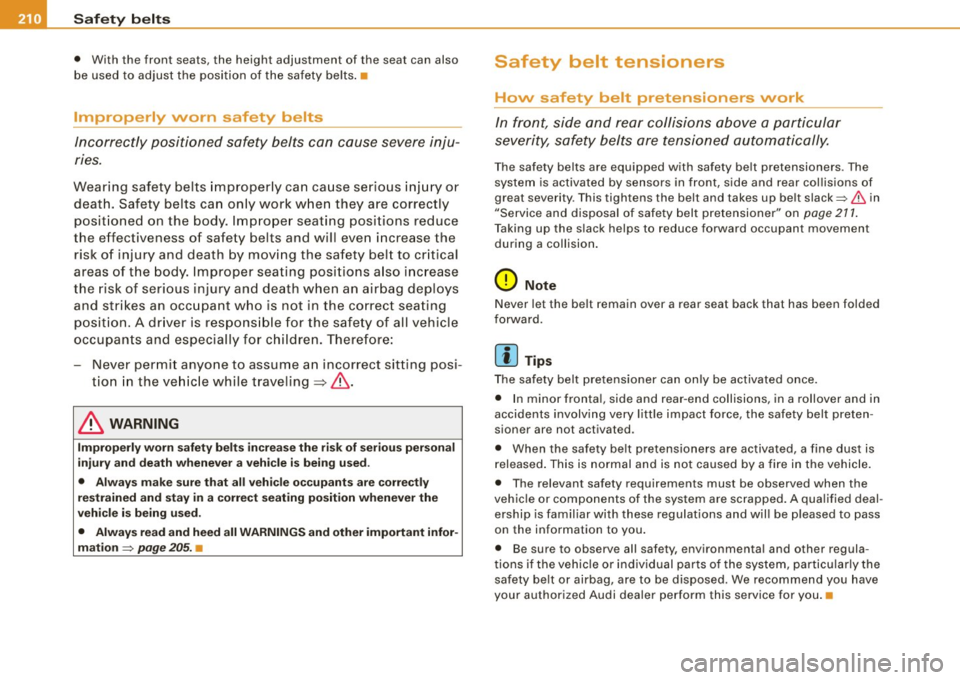
• ....__S_ a_ fe_ t _y=-- b_ e_ lt_s ________________________________________________ _
• With the front sea ts, the height adjustment of the seat can also
be used to adjust the position of the safety belts. •
Improperly worn safety belts
Incorrectly positioned safety belts can cause severe inju
nes.
Wearing safety belts improperly can cause serious injury or
death. Safety belts can only work when they are correctly positioned on the body. Improper seating positions reduce
the effectiveness of safety belts and w ill even increase the
risk of injury and death by moving the safety belt to critical
areas of the body. Improper seating positions also increase
the risk of serious injury and death when an airbag deploys
and strikes an occupant who is not in the correct seating
position. A driver is responsible for the safety of all vehicle
occupants and especially for children. Therefore:
-Never permit anyone to assume an incorrect sitting pos i
tion in the vehicle while traveling ~& .
& WARNING
Improperly worn safety belts increase the risk of serious personal
injury and death whenever a vehicle is being used.
• Always make sure that all vehicle occupants are correctly
restrained and stay in a correct seating position whenever the
vehicle is being used.
• Always read and heed all WARNINGS and other important infor
mation
~ page 205. •
Safety belt tensioners
How safety belt pretensioners work
In front, side and rear collisions above a particular
severity, safety belts are tensioned automatically.
The safety belts are equipped with safety belt pretensioners . The
system is activated by sensors in front, side and rear collisions of
great severity . This tightens the belt and takes up belt slack~
& in
"Service and disposal of safety belt pretensioner" on
page 211.
Taking up the slack helps to reduce forward occupant movemen t
during a collision.
0 Note
Never let the belt remain over a rear seat back that has been folded
forward .
[ i] Tips
The safety belt pretensioner can only be activated once.
• In minor frontal, side and rear -end collisions, in a rollover and in
accidents involving very little impact force, the safety belt preten
sioner are not activated .
• When the safety belt pretensioners are activated, a fine dust is
released. This is normal and is not caused by a fire in the vehicle.
• The relevant safety requirements must be observed when the
vehicle or components of the system are scrapped. A qualified deal
ership is familiar with these regulations and will be pleased to pass
on the information to you.
• Be sure to observe all safety, environmental and other regula
tions if the vehicle or individual parts of the system, particularly the
safety belt or airbag , are to be disposed . We recommend you have
your authorized Audi dealer perform this service for you. •
Page 213 of 390
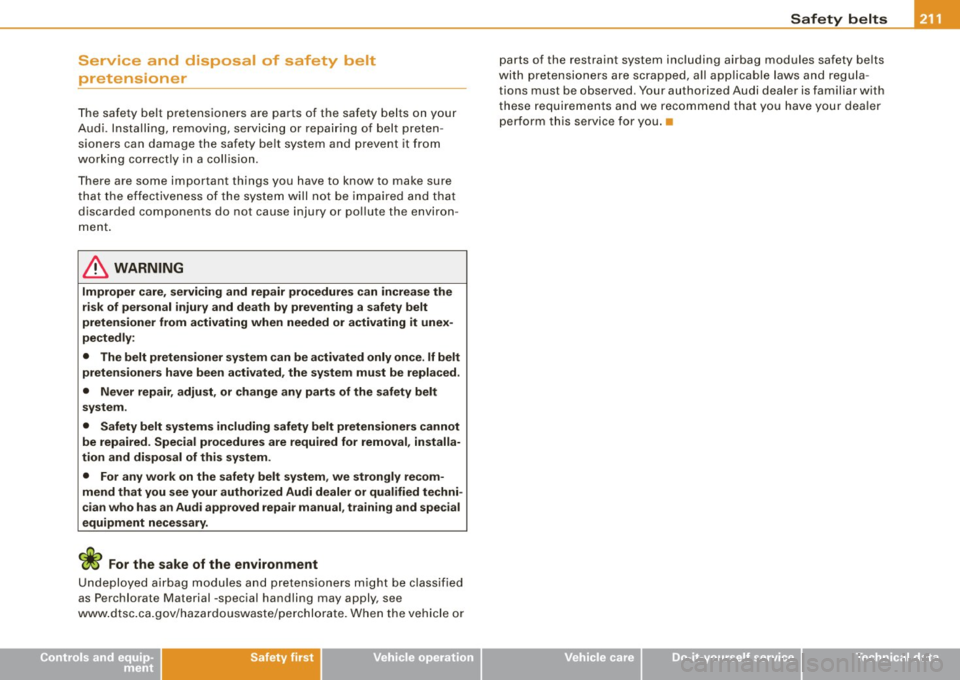
Safety b elts -----------------=------
Service and disposal of safety belt
pretension er
The safety belt pretensioners are parts of the safety belts on your
Audi. Installing, remov ing, servic ing or repair ing of belt preten
sioners can damage the safety be lt system and prevent it from
working correctly in a coll ision.
T here are some important things you have to know to make sure
that the effectiveness of the system will not be impaired and that
discarded components do not cause injury or po llute the environ
ment .
& WARNING
Improper car e, servicing and repair proc edure s can incr ease the
ri sk of p ers onal injury and d eat h by pre venting a safety b elt
pret ensioner from activating whe n ne eded o r activating it un ex
p ec tedly :
• The belt preten sioner sy stem can be activated only once. If belt
p reten sion ers ha ve been activated , the syste m mu st be repl aced.
• Never repair , adju st, or chan ge any parts o f the safet y belt
s y stem .
• Safety belt sy stem s includin g safety belt preten sion ers cannot
be r epaired . Spe cial pro cedure s are requ ired for r emoval , in sta lla
tion and di spo sal of t his sys tem .
• For an y wor k on the safet y be lt sy stem , we strongl y rec om
mend that you see your authori zed Audi de aler or qua lifi ed techni
cian w ho has an Aud i appro ved rep air m anu al, t ra ining a nd spe cial
equipment n ece ssa ry.
W For the sake of the environm ent
Undeployed airbag modu les and pretensioners might be c lassified
as Perchlorate Material -special handling may apply, see
www .dtsc .ca .gov/hazardouswaste/perchlorate. When the vehicle or
Controls and equip ment Safety first Vehicle operation parts of the restraint system including airbag modules safety belts
with pretensioners are scrapped, a ll applicable laws and regu la
tions must be observed. Your authorized Audi dealer is familiar with
these requirements and we recommend that you have your dea ler
perform this service for you. •
Vehicle care Do-it-yourself service Technical data
Page 214 of 390
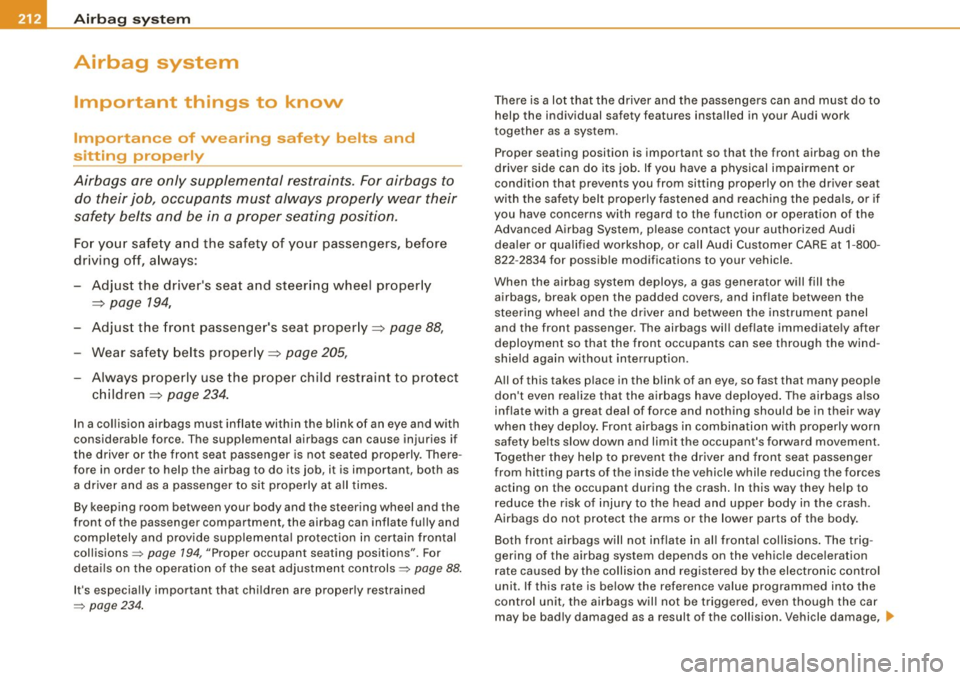
-Airbag s yste m Ptrf _______________ _
Airbag system
Important things to know
Importance of wearing safety belts and
sitting properly
Airbags are only supplemental restraints. For airbags to
do their job, occupants must always properly wear their
safety belts and be in a proper seating position.
For your safe ty a nd the safety of your passengers, before
driving o ff, a lways:
- Adjust the driver's seat and steering wheel properly
~ page 194,
-Adjust the front passenger's seat properly~ page 88,
- Wear safety belts properly~ page 205,
-Always properly use the proper child restraint to pro tect
children~
page 234 .
In a col lision airbags must inflate within the blink of an eye and with
considerable force. The supplemental airbags can cause injuries if
the driver or the front seat passenger is not seated properly. There
fore in order to help the airbag to do its job, it is important, both as
a driver and as a passenger to sit properly at a ll times.
By keep ing room between your body and the steering wheel and the
front of the passenger compartment, the airbag can inflate fu lly and
comp letely and prov ide supplementa l protection in certain frontal
collisions =>
page 194, "Proper occupant seating positions". For
detai ls on the operation of the seat adjustment controls=>
page 88.
It's especially important that children are properly restrained
=>
page 234 .
There is a lot that the driver and the passengers can and must do to
help the individual safety features installed in your Audi work
together as a system.
P roper seating position is important so that the front airbag on the
driver side can do its job. I f you have a physical impairment or
condition that prevents you from sitting properly on the driver seat
with the safety belt properly fastened and reaching the pedals, o r if
you have concerns with regard to the function or operation of the
Advanced Airbag System, p lease contact your authorized Audi
dea ler or qua lif ied workshop, or call Audi Customer CARE at 1-800-
822 -2834 for possib le modifications to your vehicle.
When the airbag system deploys, a gas generator wi ll fill the
airbags, break open the padded covers, and inflate between the
steering wheel and the driver and be tween the instrument panel
and the front passenger. The airbags wil l deflate immediate ly after
deployment so that the front occupants can see through the wind
shield again without interruption .
A ll of this takes p lace in the b link of an eye, so fast that many people
don't even rea lize that the airbags have dep loyed . The airbags also
inflate with a great deal of force and nothing should be in their way
when they dep loy. Fron t airbags in combination wi th properly worn
safety belts slow down and limit the occupant's forward movement.
T ogether they help to prevent the driver and front seat passenger
from hitting parts of the inside the vehicle while reducing the forces act ing on the occupant during the crash . In this way they he lp to
reduce the r isk of injury to the head and upper body in the crash.
Airbags do not protect the arms or the lower parts of the body .
Both front airbags will not in flate in al l fro ntal col lisions . The trig
gering of the airbag system depends on the vehic le decelerat ion
r ate caused by the colli sion and registe red by the electronic contro l
unit. If this rate is below the reference value programmed into the
cont rol unit, the airbags w ill not be t riggered, even though the car
may be bad ly damaged as a result of the collision. Vehicle damage, .,,,.
Page 215 of 390
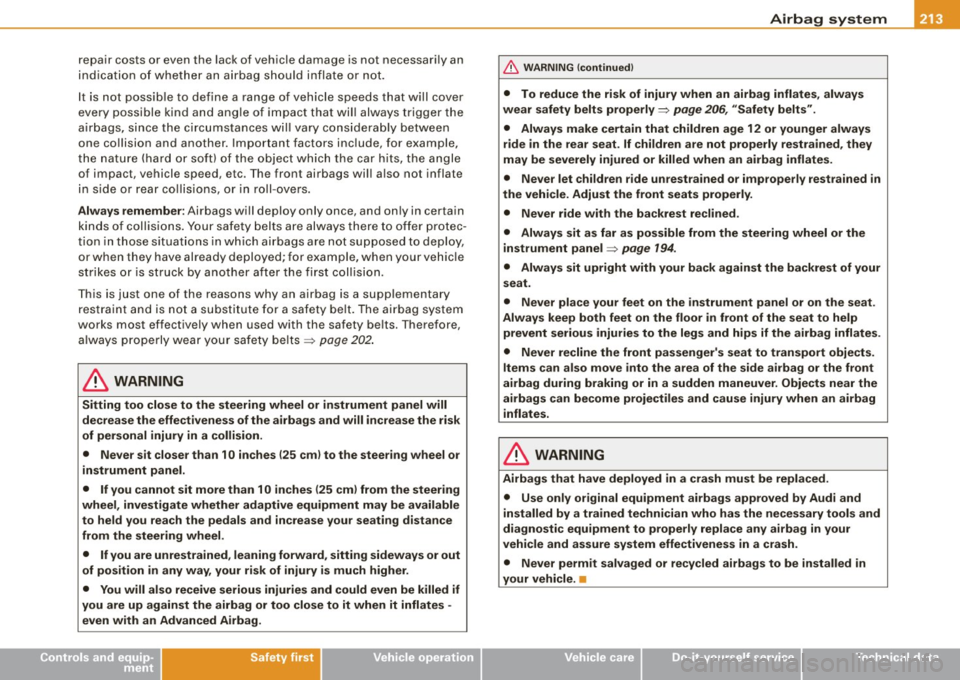
Airbag syst em -----------------=~-
repair costs or even the lack of vehicle damage is not necessari ly an
indication of whether an airbag should inflate or not.
It is not possible to define a range of vehicle speeds that will cover
every possible kind and ang le of impact that wil l always trigger the
airbags, since the circumstances wil l vary considerab ly between
one collision and another. Important factors include, for example,
the nature (hard or so ft) of the object which the car hits, the angle
of impact, vehicle speed, etc. The front airbags wi ll also not inflate
in side or rear co llisions, or in roll -overs .
Al way s rem ember : Airbags wi ll deploy only once, and on ly in certain
kinds of coll isions . Your safety belts are always there to offer protec
tion in those situat ions in wh ich airbags are not supposed to deploy,
or when they have already deployed; for example, when your vehic le
strikes or is struck by another a fter the first coll ision.
T his is just one of the reasons why an airbag is a supplementary
restraint and is not a substitute for a sa fety be lt. The airbag system
works most effectively when used with the safety be lts. Therefore ,
a lways prope rly wea r your safety belt s =>
page 202 .
& WARNING
Sitting too clo se to the steering wheel or in strument panel will
de crease the effect ivene ss of the airbags and will incr ease the risk
of personal injury in a collision.
• Never sit closer than 10 in ches (25 cm) to the steering wheel or
in strument panel.
• If you c annot sit more than 10 in ches (25 cm ) from the steering
wheel , inve stiga te whether adaptive equipment may be available
to held you reach the pedal s and in crease your se ating dist ance
from the steering wheel.
• If you are unrestra ined , leaning forward , sittin g side ways or out
of position in any way , your risk of injury i s much higher .
• You will also receive serious injur ies and could even be killed if
you are up again st the airba g or too clo se to it when it infl ates -
ev en with an Advanced Airbag .
Controls and equip ment Safety first
Vehicle operation
& WAR N IN G ( continued )
• To reduce the ri sk of injury when an airbag inflate s, alw ays
wear safety belt s prope rly~
page 20 6, "S afet y belt s".
• Always make certain that ch ildren age 12 or younger alway s
ride in the rear seat. If children are not p rope rly re str ained , they
may be severely injured or killed when an airbag inflate s.
• Never let children ride unre str ained or impr operly rest rained in
the vehicl e. Adju st the front seat s properly .
• Never ride with the b ackrest r eclined .
• Alway s sit a s far as possible from the steering wheel or the
instrument panel ~
pag e 194.
• Alway s sit upright with your back again st the backre st of your
seat .
• Ne ver pla ce your feet on the instrument panel or on the seat .
Always keep both feet on the floor in front of the seat to help
prevent seriou s injurie s to the leg s and hips if the airbag inflate s.
• Nev er r ecline th e front passenger 's seat to transpo rt obje cts .
Item s can al so mo ve into the area of the side a irbag or the front
airbag during braking or in a sudden m aneuver . Obje cts near the
a irbags can become pro je ctile s and cau se injury when an airbag
inflates .
& WARNING
Airbags that have deployed in a crash must be repla ced.
• U se only original equipment airbags approved by Audi and
in stalled by a trained technician who ha s the neces sary tool s and
diagnostic equipment to properly r epla ce any airb ag in your
vehicle and as sure sy stem effectivenes s in a crash .
• Never perm it salvag ed or re cy cled airb ag s to be i nstall ed in
your vehicle. •
Vehicle care Do-it-yourself service Technical data
Page 216 of 390
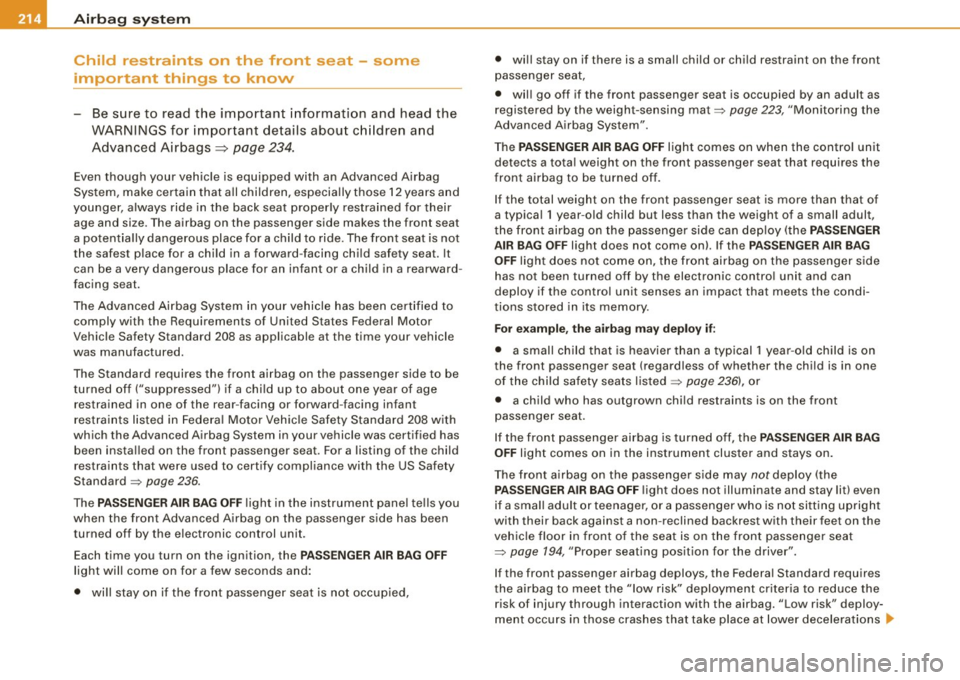
llffl __ A_ ir_ b_ a-g _ s_y _s_ t_ e_ m _________________________________________________ _
Child restraints on the front seat - some
important things to know
-Be sure to read the important information and head the
WARNINGS for important details about ch ildren and
Advanced Airbags~
page 234.
Even though your vehic le is equipped with an Advanced Airbag
System, make certain that a ll children, especia lly those 12 years and
younger , always ride in the back seat proper ly restrained for their
age and size . The airbag on the passenger side makes the front seat
a potentia lly dangerous place for a child to ride. The front seat is not
the safest place for a chi ld in a forward -facing child safety seat. It
can be a very dangerous place for an infant or a child in a rearward
facing seat.
The Advanced Ai rbag System in your vehicle has been certified to
comply with the Requirements of United States Federal Motor
Vehicle Safety Standard 208 as applicable at the time your vehicle
was manufactured.
The Standard requires the front airbag on the passenger side to be
turned off ("suppressed") if a chi ld up to about one year of age
restrained in one of the rear-facing or forward-facing infant res traints listed in Federa l Motor Vehicle Safety Standard 208 with
which the Advanced Airbag System in your vehicle was cert ified has
been insta lled on the front passenger seat. For a listing of the child
restraints that were used to certify compliance with the US Safety
Standard =>
page 236.
The PASS ENGER AIR B AG OFF light in the instrument panel tells you
when the front Advanced Airbag on the passenger side has been
t urned off by the electronic control unit.
Each time you turn on the ignition , the
PASSEN GER AIR BA G OFF
light will come on for a few seconds and:
• will stay on if the front passenger seat is not occupied, •
will stay on if there is a small child or child restraint on the front
passenger seat,
• will go off if the front passenger seat is occupied by an adult as
registered by the weight-sensing mat=>
page 223, "Monitoring the
Advanced Airbag System" .
The
P AS SENGER AIR BAG OFF light comes on when the control unit
detects a tota l weight on the front passenger seat that requires the
front airbag to be turned off.
If the total weight on the front passenger seat is more than that of
a typica l 1 year -old child but less than the weight of a small adult,
the front airbag on the passenger side can deploy (the
PA SSE NGER
A IR BA G OFF
light does not come on). If the P ASSE NGER AIR B AG
O FF
light does not come on, the front airbag on the passenger s ide
has not been turned off by the electronic control unit and can
deploy if the control unit senses an impact that meets the condi
tions stored in its memory.
F o r e xample , th e a ir b ag m ay dep loy if:
• a small ch ild that is heavier than a typical 1 year -o ld child is on
the front passenger seat (regardless of whether the child is in one
of the child safety seats listed
=> page 236), or
• a child who has outgrown chi ld restraints is on the front
passenger seat.
If the front passenger airbag is turned off, the
PASSEN GER AIR BA G
OFF
light comes on in the instrument cluster and stays on.
The fron t airbag on the passenger side may
not deploy (the
PA SS ENGER AIR BA G OFF light does not illuminate and stay lit) even
if a small adult or teenager, or a passenger who is no t sitting upright
with their back against a non -reclined backrest with their feet on the
vehic le floor in front of the seat is on the front passenger seat
=> page 194, "Proper seating position for the driver".
If the front passenger airbag deploys, the Federal Standard requires
the airbag to meet the "low risk" deployment criteria to reduce the risk of injury through interact ion with the airbag. "Low risk" d eploy
ment occu rs in those crashes that take place at lower decelerations .,.
Page 217 of 390
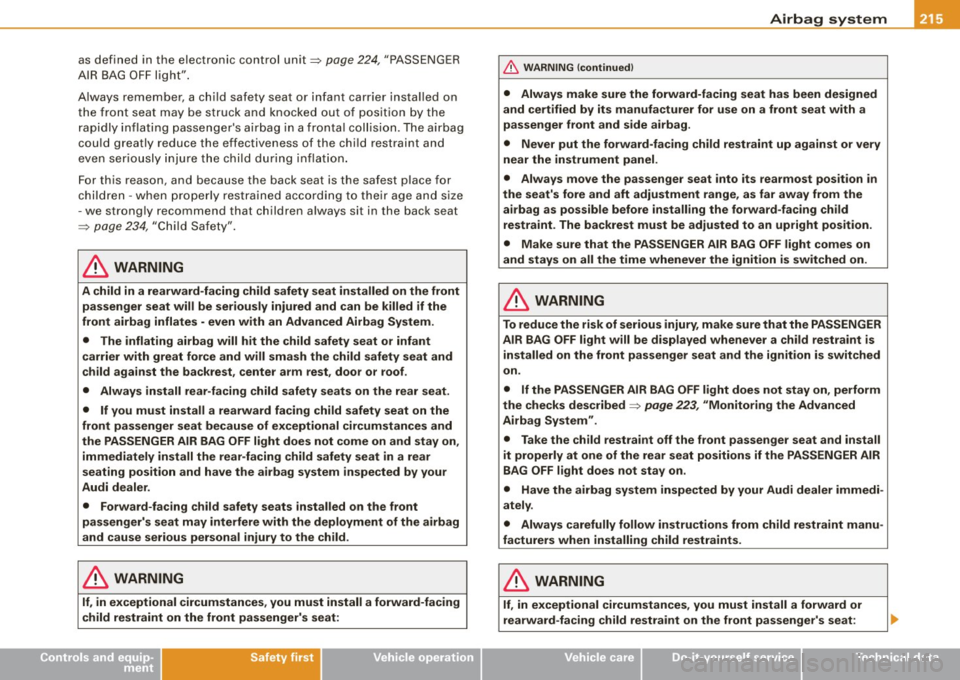
Airbag system -----------------=~-rm-I
as defined in the electronic control unit~ page 224, "PASSENGER
AIR BAG OFF l igh t" .
A lways remember, a chi ld safety seat or infant carrier insta lled on
the front seat may be struck and knocked out of position by the
rap id ly i nfl ating pass eng er's ai rbag in a frontal co llision . The airba g
co uld greatly reduce the effectiveness of the chi ld restraint and
even s erio usly in jure the chi ld du ring infl ation.
F or this reason, and because the bac k seat is the safest place for
c h ildr en -w he n prop erly res trained a cc or ding to th eir age an d size
- w e stro ngly recomm end that c hildren a lwa ys s it in th e back seat
~ page 234, "C hil d Safe ty" .
& WARNING
A child in a rearward -facing child safety seat installed on the front
passenger seat will be seriously injured and can be killed if the
front airbag inflates - even with an Advanced Airbag System.
• The inflating ai rbag will hit the child safety seat o r infant
carrier with great force and will smash the child safety seat and
child against the ba ckrest , center arm rest , door or roof.
• Always install rear-facing child safety seats on the rear seat.
• If you must install a rearward facing child safety seat on the
front pa ssenger seat because of exceptional circumstances and
the PASSENGER AIR BAG OFF light does not come on and stay on,
immediately install the rear-facing child safety seat in a rear
seating position and have the airbag system inspected by your
Audi dealer .
• Forward-facing child safety seats installed on the front
pa ssenger's seat may interfere with the deployment of the airbag
and cause serious personal injury to the child .
& WARNING
If, in exceptional circumstances , you must install a forward-facing
child restraint on the front passenger's seat:
Controls and equip ment Safety first
Vehicle operation
& WARNING (continued)
• Always make sure the forward-facing seat has been designed
and certified by its manufacturer for use on a front seat with a
passenger front and side airbag .
• Never put the forward-facing child restraint up against or very
near the instrument panel .
• Always move the passenger seat into its rearmost position in
the seat's fore and aft adjustment range, as far away from the
airbag as possible before installing the forward-facing child
restraint. The backrest must be adjusted to an upright position .
• Make sure that the PASSENGER AIR BAG OFF light comes on
and stays on all the time whenever the ignition is switched on.
& WARNING
To reduce the risk of serious injury , make sure that the PASSENGER
AIR BAG OFF light
will be displayed whenever a child restraint is
installed on the front passenger seat and the ignition is switched
on.
• If the PASSENGER AIR BAG OFF light does not stay on , perform
the checks described
~ page 223 , "Monitoring the Advanced
Airbag System" .
• Take the child restraint off the front passenger seat and install
it properly at one of the rear seat positions if the PASSENGER AIR
BAG OFF light does not stay on .
• Have the airbag system inspected by your Audi dealer immedi
ately .
• Always carefully follow instructions from child restraint manu
facturers when installing child restraints .
& WARNING
If, in exceptional circumstances, you must install a forward or
rearward-facing child restraint on the front passenger's seat :
Vehicle care Do-it-yourself service Technical data
Page 218 of 390
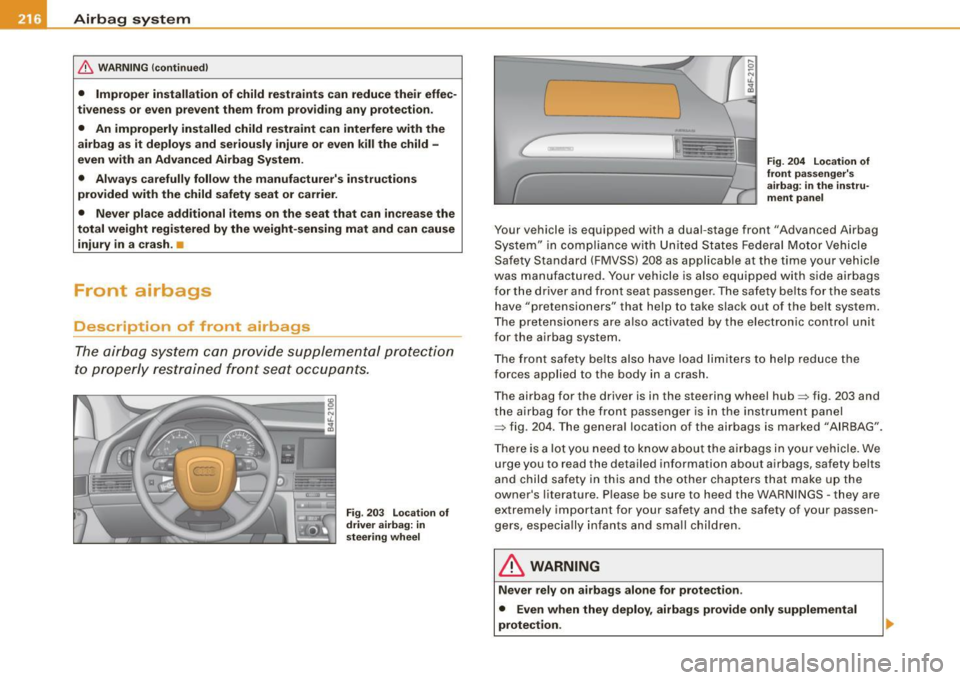
___ A_ ir_b _a_ g;:::;_ s--:.. y_s _t _e _m _________________________________________________ _
& WARNING (con tinued )
• Improper in stallation of child re straints can reduce their effec
tiveness or even prevent them from p roviding any protection .
• An improperly installed child re straint can interfere with the
airbag as it deploys and seriously injure or even kill the child -
even with a n Advanced Airbag System .
• Always carefully follow the manufa cturer's instruction s
provided with the child safety seat or carrier .
• Never pl ace additional items on the seat that can in crease the
total weight regi stered by the weight -sensing mat and can cause
injury in a crash .
u
Front airbags
Description of front airbags
The air bag system c an pr ovi de su ppleme ntal pr otecti on
t o prop erl y re stra ined fr ont se at occu pant s.
Fig . 203 Location of
driver airbag: in
s teering wheel
(
Fig . 204 Locat ion of
front pa ssenger' s
airbag : in the in stru
ment pa nel
Your vehicle is equipped with a dual -stage front "Advanced Airbag
Sys tem" in com pliance w ith United Sta tes Fede ral Mo tor Vehicle
Safety Standard (F MVSS) 208 as applicab le at the time your v ehicle
was man ufactured. Yo ur vehicle is also equipped w ith side air bags
f o r th e dr iver and fro nt seat passen ger. T he sa fety be lts fo r the seats
have "pretensioners" that help to take slack out of the be lt system.
T he pre tensio ners are a lso activated by the electronic co ntro l un it
for the airbag system.
T he fron t safety be lts als o have load li m ite rs to hel p red uce the
forces applied to the body in a crash.
T he airbag for the driver is in the steering wheel hub=:, fig. 20 3 and
t h e ai rbag for t he front passeng er is in the inst rument pane l
=:, fig. 204. The genera l location of the ai rbags is marked "A IRBAG".
There is a lo t you need to know ab out the airbags in y our vehicle. We
urge you to read the detailed information about airbags, safety belts
and chil d safety in this a nd th e other cha pters t hat make up the
owner's l iterature. Please be sure to heed the WAR NINGS -th ey are
extremely important for your safety and the safety of your passen
gers, especia lly infants and sma ll children .
& WARNING
Never rely on airbags alone for prote ction .
• Even when they deploy, airbag s provide only supplemental
protection .
Page 219 of 390
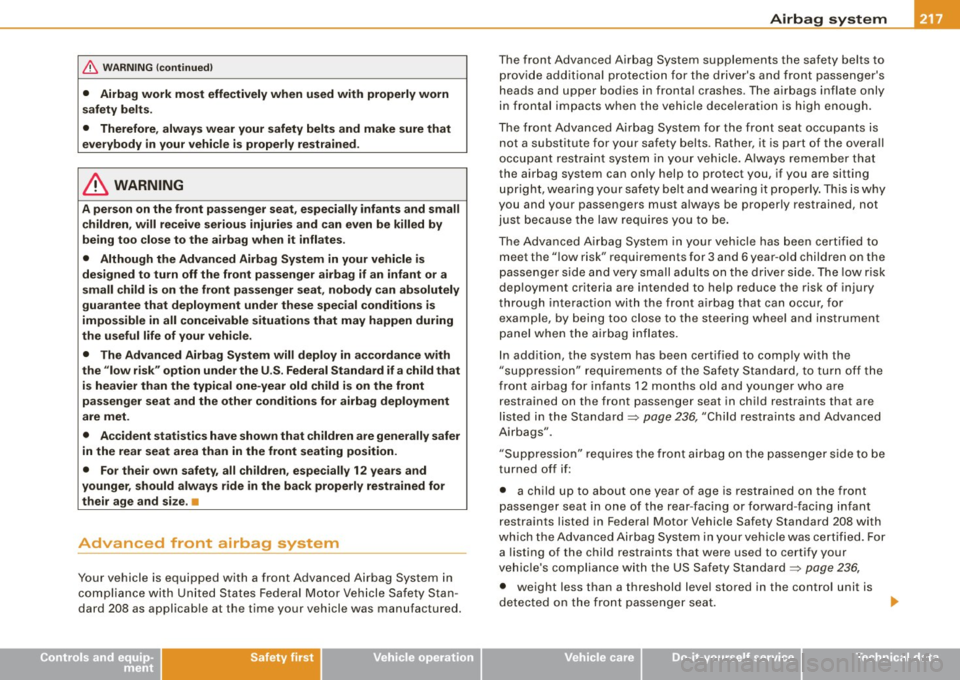
__________________________________________________ A_ i_ r _b _a...; g::- s_ y=--- s_t _e _m __ fflllll
& WA RN ING (co ntinued)
• Airb ag work mo st effectively when u sed with prope rly worn
s afety belts.
• Therefore , alwa ys wear your safety be lt s and make sure that
ev erybod y i n yo ur vehi cle is properly re str ained.
& WARNING
A pe rson on the front pa ssen ger s eat , e spe cially inf ants and small
c hildren , w ill re ceive s eriou s injurie s and can ev en be killed by
being too cl ose to the airbag whe n it infl ates .
• Although the Advan ced Airba g System in your vehicle i s
de signed t o tu rn off the front p assenger airb ag i f a n inf ant or a
s mall child i s on the front pa ssenger seat , nobod y can absolut ely
gu ara nt ee that deployment under these spe cial con ditio ns is
impo ssible in all conc eivable situations that m ay happen during
the useful l ife of your vehic le.
• The Adv anced Airbag Sy stem will deploy in a ccordance with
the "lo w risk" opti on u nder th e U.S. Feder al Stand ard if a child t hat
i s heavier than th e typi cal on e-year old child i s on the front
p asse nger seat and the other conditi ons for airb ag dep loym ent
are met.
• Acc ident stat istics have shown that children are gener ally s afe r
in the rear seat ar ea than in the front seating po sit ion .
• Fo r their o wn safet y, all children , espe cially 12 yea rs and
younger , should always r ide in the back properly restrained for
their age and siz e. •
Advanced front airbag system
Your vehicle is equipped with a front Advanced Airbag System in
compliance with United States Federal Motor Veh icle Sa fety Stan
dard 208 as applicab le at the time your vehicle was manufactured.
Controls and equip ment Safety first Vehicle operation The front Advanced Airbag System supplements the safety belts to
provide additional protection for the driver's and front passenger's
heads and upper bodies in fronta l crashes. The airbags inflate only
in frontal impacts when the vehic le dece leration is high enough.
The front Advanced Airbag System for the front seat occupants is not a substitute for your safety belts. Rather, it is part of the overa ll
occupant restraint system in your vehicle. A lways remember that
the airbag system can only help to protect you, if you are sitting
upright, wear ing your safety belt and wearing it properly . This is why
you and your passengers must a lways be properly restrained, not
just because the law requires you to be .
The Advanced A irbag System in your vehicle has been certified to
meet the " low risk" requirements for 3 and 6 year-o ld children on the
passenger side and very small adults on the driver side. The low risk
deployment criteria are intended to he lp reduce the risk of injury
through interact ion wi th the front a irbag that can occur, for
examp le, by being too close to the steering whee l and instrument
panel when the airbag inflates.
In addition, the system has been certified to comply with the
"suppression" requirements of the Safety Standard, to turn off the
front airbag for infants 12 months old and younger who are restrained on the front passenger seat in child restraints that are
listed in the Standard:::::,
page 236, "Child restraints and Advanced
Airbags".
"Suppression" requires the front ai rbag on the passenger side to be
turned off if:
• a child up to about one year of age is restrained on the front
passenger seat in one of the rear-facing or forward -facing infant
restraints listed in Federal Motor Vehicle Safety Standard 208 with
wh ich the Advanced Airbag System in your vehicle was certif ied. For
a listing of the child restraints that were used to certify your
vehicle's compliance with the US Safety Standard:::::,
page 236,
• weight less than a threshold leve l stored in the control unit is
detec ted on the front passenger sea t. .._
Vehicle care Do-it-yourself service Technical data
Page 220 of 390
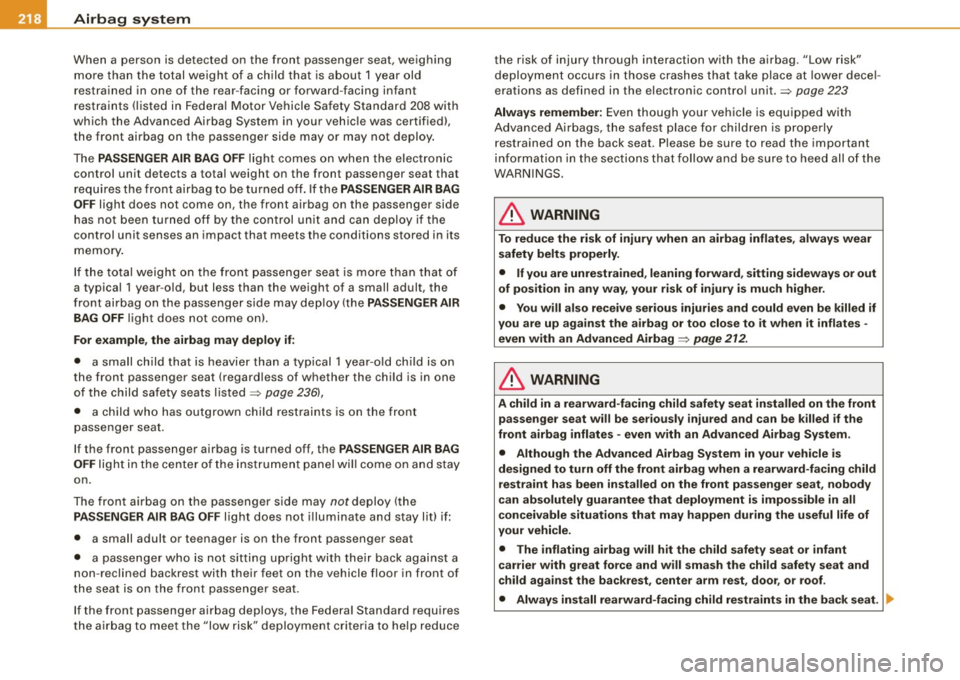
___ A_ ir_ b_ a-g _ s_y _s_ t_ e_ m _________________________________________________ _
When a person is detected on the front passenger seat, weighing
m ore tha n the to tal weigh t of a c hild that is ab out 1 year old
restra ined in one of the rear -fac ing or forward -facing infant
r es traints (listed in Fede ra l M oto r Vehicle Safe ty S ta ndard
208 with
which the Advanced Airba g System in your ve hic le was certified),
the fro nt airbag on the pas se nge r si de may o r may not dep loy .
The
PASSENGER AIR BAG OFF li gh t com es o n when the elect ro ni c
contro l unit detects a total weight on the front passenger seat that
requ ires th e front ai rbag to be tur ned off. If th e
PASSENGER AIR BAG
OFF
light does not come on, the front airbag on the passenger side
h as not been tu rned off by the c ontrol unit and can depl oy if the
control unit senses an impact that meets the conditions stored in its memo ry .
If t he to tal we ight on the fro nt passen ge r seat is more t han t hat of
a typical
1 year -old, but less than the weight of a small adult, the
fro nt a irba g on t he passen ger side may dep loy (the
PASSENGER AIR
BAG OFF
li ght does not come onl.
For example, the airbag may deploy if:
• a small ch ild that is heav ie r th a n a typ ical 1 yea r-old ch ild is o n
the front passenger seat (regardless of whether the child is in one
o f th e ch ild sa fety seats listed=>
page 236),
• a ch ild wh o ha s ou tg rown chi ld re strain ts is on the fron t
passen ger seat.
If the front passenge r airbag is turned off, the
PASSENGER AIR BAG
OFF
lig ht in the ce nter of t he inst rument panel wi ll co me on a nd stay
on.
The fron t airb ag o n the passenger side may
not deploy (the
PASSENGER AIR BAG OFF lig ht does not i llu m ina te and s ta y lit) i f:
• a small adu lt or teenager is on the front passenger seat
• a passenger who is no t sitt ing up rig ht with the ir back aga inst a
non -reclined bac krest with their feet on the vehicle f loor in front of
t h e seat is on th e fro nt pass enger se at.
If the front passenger airbag deploys, the Federa l Standard requires
t he a irbag to m eet th e "low ri sk" deploy ment criter ia to he lp reduce the risk of injury through interaction with the airbag. "
Low risk"
d eployme nt occ urs in those cras hes that ta ke place a t lower de ce l
e rations as defined in the electron ic contro l unit .=:>
page 223
Always remember : Even though your vehicle is equipped with
A dva nced Air bags , th e sa fes t place fo r chi ldren is properly
r estra ined on the back seat. Please be sure to read the important
i nf orm atio n in t he sect ions t hat follow and b e sur e to hee d all of the
WARN INGS.
& WARNING
To reduce the risk of injury when an airbag inflates, always wear
safety belts properly.
• If you are unrestrained, leaning forward , sitting sideways or out
of posit ion in any way, your risk of injury is much higher.
• You will also receive serious injuries and could even be killed if
you are up against the airbag or too close to it when it inflates -
even with an Advanced Airbag=:>
page 212.
& WARNING
A child in a rearward -facing child safety seat installed on the front
passenger seat will be seriously injured and can be killed if the
front airbag inflates -even with an Advanced Airbag System .
• Although the Advanced Airbag System in your vehicle is
de signed to turn off the front airbag when a rearward -facing child
restraint has been installed on the front passenger seat , nobody
can absolutely guarantee that deployment is impossible in all
conceivable situations that may happen dur ing the useful life of
your vehicle.
• The inflating airbag will hit the child safety seat or infant
carrier with great force and will smash the child safety seat and
c hild against the backrest , center arm rest , door , or roof .
• Always install rearward -facing child restraints in the back seat . ..,.